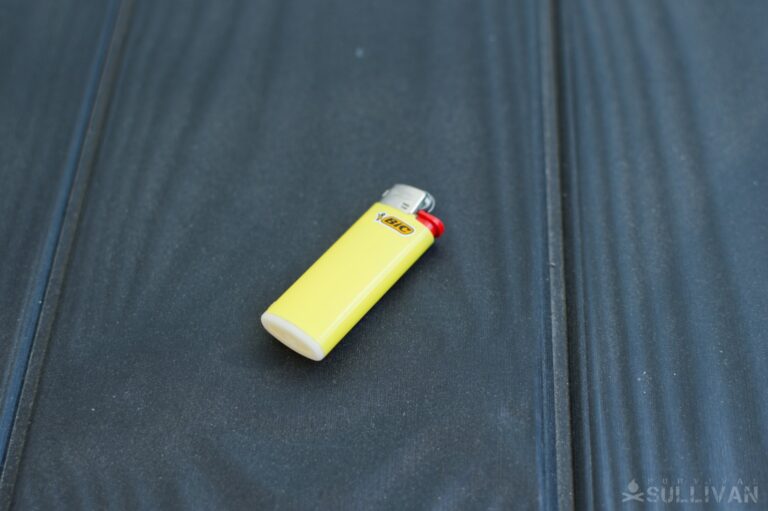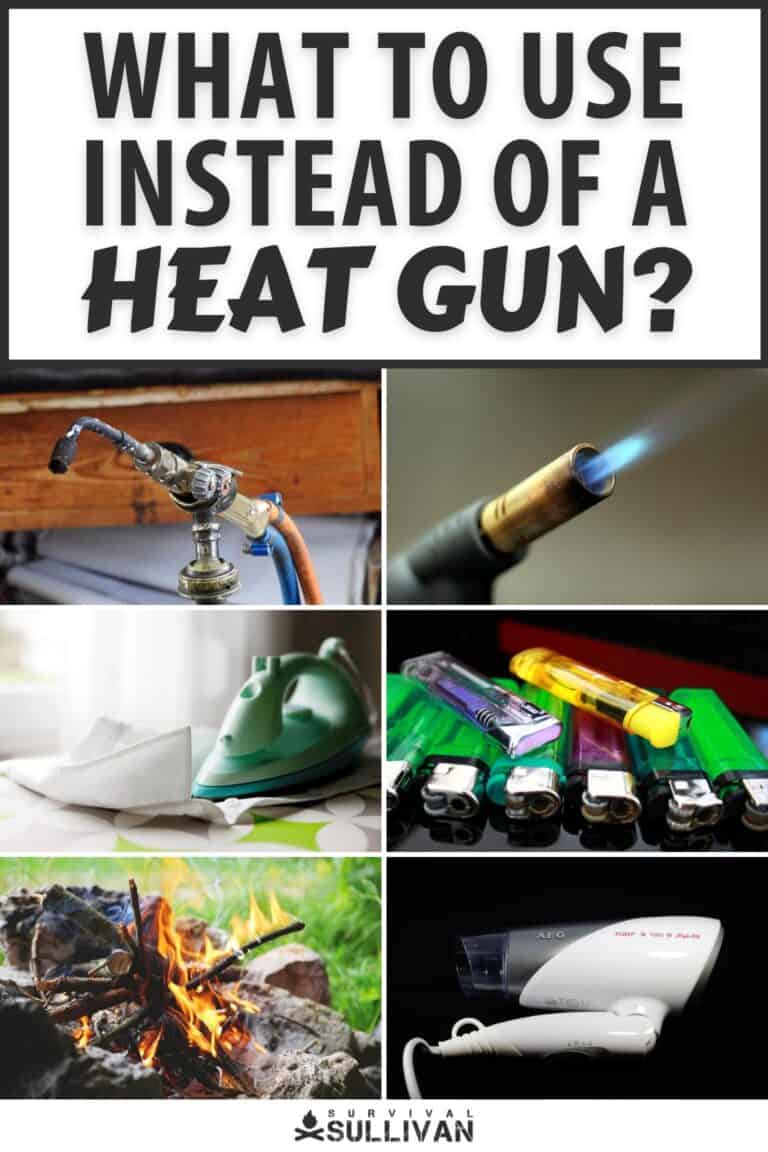A heat gun is a valuable tool to have in your home improvement arsenal, but what do you do when it’s broken or you just don’t have one?

Like they say, where there is a will, there is a way. But what can you use if you don’t have a heat gun?
Good alternatives to heat guns are an open flame, hair dryer, lighter, butane/propane torch, clothes iron, Bunsen burner, grill, or a cooktop. All can work depending on the nature of the task at hand and can be used safely with some caution.
Luckily you have no shortage of tools and techniques that can provide the controlled heat you need. In this article, we will discuss seven alternatives that you can use in place of a heat gun.
Each has its own advantages and disadvantages, so be sure to read on to find the best option for your needs.
As Always, Safety First!
Before we get started, it is important to note that you should always take safety precautions when working with heat for any purpose, and particularly when that purpose is for heating another object.
Accidental fires or injuries can result when an object is heated up, or when the heat source is allowed to contact work or non-work surfaces.
Also, make sure you have good ventilation and wear gloves and eye protection as needed. Depending on your application a respirator or even a full-face mask could be called for.
Got it? Good. Now let’s take a look at our seven alternatives to a heat gun.
7 Alternatives to a Heat Gun that Will do the Job
Open Flame
The first and most obvious alternative is an open flame. This could be from a campfire, candle, or something else.
The advantage of using an open flame is that it is readily available, provides plenty of heat for common tasks, and is independent of electricity.
The downside is that it can be difficult to control the heat output and precise application, and then there is a strong possibility of scorching, burns and accidental fires if you aren’t careful.
If you need seriously high temps you’ll need a bigger fire, making management, not to mention fuel supply, more and more troublesome.
But for simple or crude tasks an open flame will do the trick.

Hair Dryer
A hair dryer is another common household item that can be used as an impromptu heat gun. In fact, it is little more than an underpowered heat gun as it is!
Convenient, cheap and easy to replace if something goes wrong: what’s not to like? Just don’t let your significant other find out.
Hair dryers are easy to control and handle, and will allow you to precisely apply heat to a specific area without the risks associated with an open flame.
The downsides? Well, they don’t get anywhere near as hot as a purpose-built heat gun, so you may find yourself having to make multiple passes to get the job done.
Also, most hair dryers don’t have the endurance of a proper heat gun (especially the cheap ones) and may start to shutdown or falter if you keep them on too long. Still, for simple tasks like dealing with shrink wrap or heat tubing, you won’t go wrong.

a Bic lighter
Lighter
Using a lighter directly is another option for an open flame, and while it doesn’t provide as much heat as something like a torch, it is still enough for most simple tasks like sealing heat-shrink tubing, melting the cut end of paracord or brazing small pieces of metal.
The advantage of using a lighter is that it is super small, convenient, easy to control (as long as you have one hand to spare!).
You can also use the flame to directly apply intense heat to a small target area without having to worry about scorching or burning the rest of the piece.
The downside is that lighters are greatly limited when it comes to fuel and endurance. Leaving a lighter lit for more than 30 seconds will quickly heat up the whole thing, hot enough to burn you or cause a fuel explosion.
So while a lighter is great for small, precise tasks that need high heat, it isn’t going to work so well for larger projects or anything that needs to be heated for more than a few seconds at a time.

Butane/Propane Torch
A step up from the lighter is the butane or propane torch. These are designed for more heavy-duty tasks like soldering pipes, welding and metal work.
Butane/propane torches provide a much higher heat output than lighters (up to 2000 degrees Fahrenheit), and can be used for extended periods of time without risk of overheating. The flame can also be directed to a specific target area with great precision.
The downside is that butane/propane torches can be expensive, and the fuel can be difficult to find in some areas.
They are also somewhat bulky and may require two hands to operate, which can make them difficult to use for certain tasks.
Alternately, you’ll have to set the torch on a stand to direct the flame where you need it to go, and then you’ll have all the attendant risks of an open flame.
But if you need a lot of heat for a prolonged period of time, a butane/propane torch is the way to go.
Clothes Iron
A clothes iron can be a great alternative to a heat gun, especially if you need to apply heat to a large surface area.
Irons are designed to evenly distribute heat over a wide area to de-wrinkle clothes without any open flame, and can get hot enough (up to 500 degrees Fahrenheit for some models) to handle the most stubborn fabric.
For applications where you need to apply heat under control to large, flat surfaces, a clothes iron can also be pressed into service as an emergency heat gun alternative.
The main advantage of using a clothes iron is that it will already be in your home and you probably have some experience using it safely.
They are also quite inexpensive compared to some other options on this list. On the downside, they don’t get nearly as hot as a true heat gun and cannot really be used for any task that isn’t a flat surface.

Bunsen Burner
A Bunsen burner is a laboratory device that provides heat and a controlled atmosphere for experiments.
The burner consists of a metal base with a hole in the center, over which is placed a gas nozzle. The gas is lit, and the flame is directed to the bottom of the hole to provide heat.
A wire gauze screen is placed over the hole to diffuse the flame and prevent scorching.
Bunsen burners are quite stable and can provide a lot of heat under tight control and can be used for a variety of tasks, including soldering, brazing and welding.
They are also quite inexpensive and easy to find. The main downside is that they require a gas source, which may not be readily available or applicable to your task. Additionally, the open flame can, as always, pose a safety hazard if an accident occurs.
Grills or Cooktops
If you need a ton of direct or indirect heat and have access to a grill or cooktop, you can use that as an alternative to a common heat gun.
The advantage of using a grill or cooktop is that they provide constant, reliable heat and the apparatus itself is nearly entirely flameproof: a stovetop inside your kitchen is probably the safest area to work with intense heat and a grill out in the backyard is at least outside!
The downside is that neither is as portable as a heat gun nor “aimable”: you’ll have to be really careful not to damage the item you’re working on or yourself as you try to position it near the heat!
Turn Up the Heat
So there you have it, seven alternatives to a heat gun that will get the job done in a pinch!
Each has its own advantages and disadvantages, so be sure to choose the one that is best suited to the task at hand. Be careful and good luck.

The post What to Use Instead of a Heat Gun? 7 Alternatives that Work appeared first on Survival Sullivan.
By: Tom Marlowe
Title: What to Use Instead of a Heat Gun? 7 Alternatives that Work
Sourced From: www.survivalsullivan.com/heat-gun-alternatives/
Published Date: Thu, 02 Jun 2022 11:15:32 +0000
-------------------------------------------------------------------------
Did you miss our previous article...
https://outdoorsnewswire.com/survivalist/10-tips-for-bowhunting-deer-you-need-to-know
 CampingSurvivalistHuntingFishingExploringHikingPrivacy PolicyTerms And Conditions
CampingSurvivalistHuntingFishingExploringHikingPrivacy PolicyTerms And Conditions
